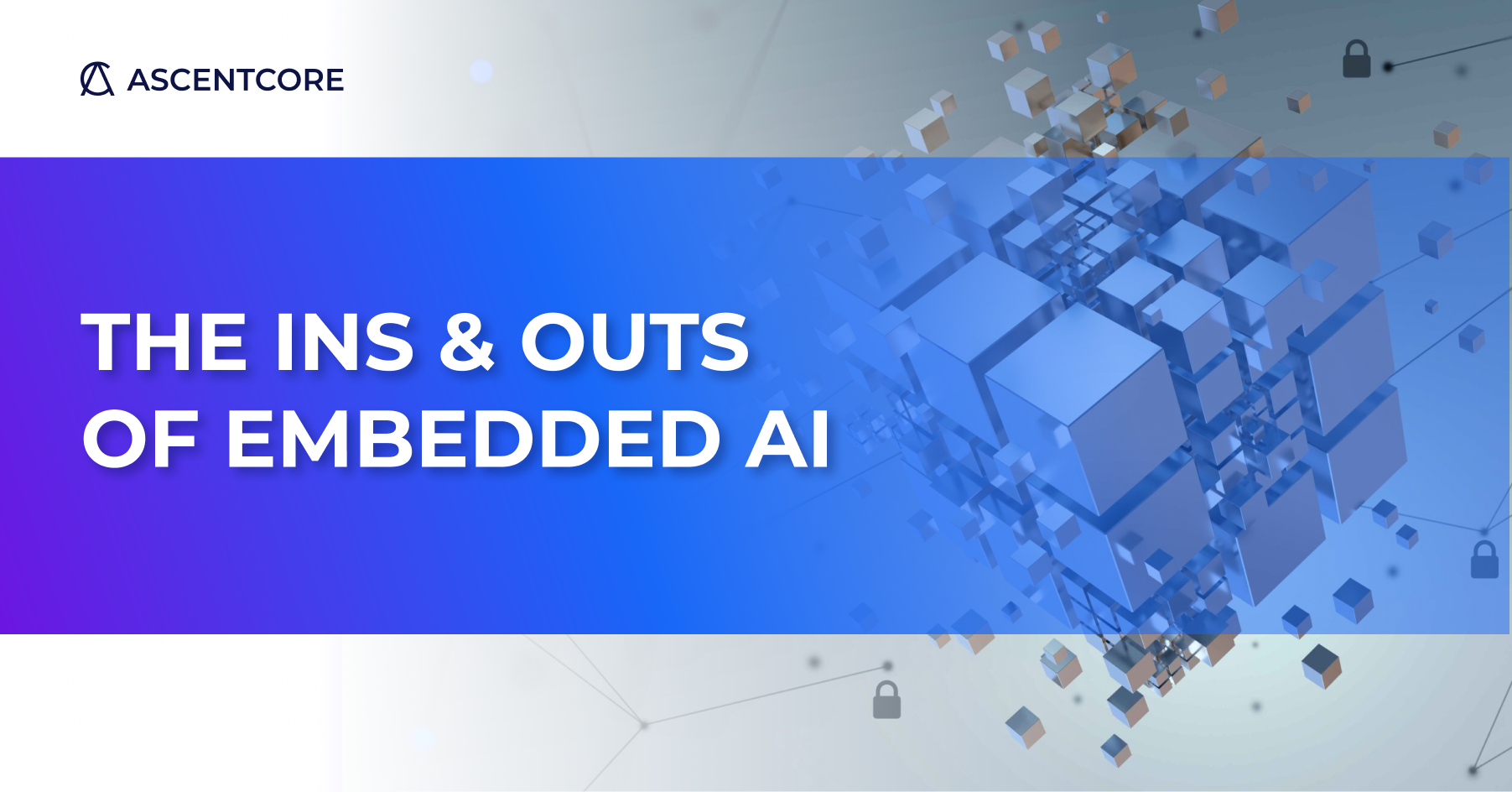At AscentCore, we’re dedicated to cultivating knowledge in areas that we’re not only passionate about, but that can help move our clients forward. Outside of their 9 to 5, our staff is busy keeping up with the latest technology, taking on new challenges, and learning from each other.
We recently had a chat with AscentCore CTO Cornel Stefanache, and AscentCore Technical Advisor Cristian Raita to learn more about his passion for embedded AI and what he’s currently working on.
Cornel Stefanache: What’s your experience in the field of embedded AI?
Cristian Raita: As a hobby, I like to work with embedded devices such as Arduino devices and STM boards, and have also worked on some projects which use both. For example, I played with the first generation camera, Intel RealSense, which has embedded AI. I’ve also had a chance to experiment with the Intel Neural Link Stick, which is another first generation technology.
Cornel Stefanache: Let’s take a step back and talk more generally about AI on embedded devices, which can require a lot of computational power. What are your thoughts on that?
Cristian Raita: Unfortunately, that’s the main drawback. It means that you have to make some trade offs when building something. So for example, you don’t want to put too much power on the board because that would increase costs significantly. But, if speed, or the transfer rate, to a server and back again, isn’t an issue, then you can make a simple embedded device connected for IOT, with the mode or by Wi-Fi, and have a lower cost on the embedded device and the data.
Cornel Stefanache: In my experience, I haven’t been interested in deploying an AI onto embedded devices, but there are some solutions to take a highly specialized neural net, strip it down to most essential nodes that contribute the most to the final decision and have a less accurate, but very light neural net or any other AI algorithm that is running on embedded devices.
Cristian Raita: Yes, and that’s why I developed tiny machine learning which you can connect to another Arduino ESP. You can also have an Arduino board connected with a Bluetooth device and you can put learning algorithms there.
For example, Movidius came and afterwards Intel bought them with the solution that’s actually that stick. It’s the computational stick, which automatically contains all the information there so you don’t need specialized hardware.
Cornel Stefanache: When we look at the different providers out there in the embedded AI field, who do you think is going to win out at the end?
Cristian Raita: It’s hard to pick just one. Intel is quite popular – they provide chips for DJI drones, for example, and those provide all of the computational data.
Another great player is Nvidia. They have the automated driving part and also are a big player in this area. They have hacker boards, such as the Jetson, which is more powerful than Raspberry, and costs about the same.
Cornel Stefanache: One key aspect I keep coming back to is the issue of privacy. Most information that’s captured is sent to a server. How do you protect privacy?
Cristian Raita: Yes, this is a huge concern. If you go to a server, then you’re showing it the GDPR and also sending information which is not user connected. That’s why, for example, if you want the devices which have AI embedded, then you automatically solve this problem, because it’s solved locally. With AI, you don’t send the data anywhere, instead it’s on the device, so you have no issue with security or other aspects.
Cornel Stefanache: Is encryption a solution to send more sensitive data to a server?
Cristian Raita: Yes, that’s certainly one solution. The only issue is what you have inside that data. If it’s user connected, then you need the agreement in Europe. In the States, it’s simpler because you don’t need that.
Cornel Stefanache: So, I have a Google home device and I’m convinced it’s listening to me, even if it’s off most of the time. How do you think that works in a privacy protecting environment?
Cristian Raita: Mostly, these types of devices are trying to learn and to understand your patterns. For example, embedded devices will try to learn and predict your actions which is why you may be surprised if it suggests something you only thought of or mentioned in passing. But the reality is that it’s improving based on your past behavior. But the device isn’t actually listening the way a human ear does. The main goal of this type of AI is to make predictions.
Cornel Stefanache: Is learning possible on low-power social devices?
Cristian Raita: On low power devices, learning isn’t quite as possible. Low power devices don’t automatically contain computational power because the user consumes too much power. Also, low power devices require real-time decision making so you need a real -time OS which won’t have this capability. You typically only see AI in devices with more computational power. For example, Amazon is developing a drone that’s currently in beta. It has AI inside because it needs to be able to make decisions such as when to avoid running into something. So that computational power will be there but it will drive up the cost.
Cornel Stefanache: What do you see as some of the main ways in which AI will help us live better?
Cristian Raita: AI and embedded systems will improve our lives mainly in the areas which are, let’s say, repetitive. In factories, for example, you see their strength. Tesla is working on a robot that can be very human-like and take on repetitive tasks while also learning and predicting future behavior. It will also help reduce mistakes and accidents and help people be the best at their job. Industries such as security, IT, and medical, can definitely benefit from this type of embedded AI technology.
Cornel Stefanache: And I would add a cool example I’ve seen from Nvidia. They’ve used a 3D model of the Boston dynamics dog in a real physics environment. They’ve placed 1,000 such simulated agents into a real physics environment with various terrain and let them learn how to navigate that terrain. That terrain was really complex and they trained it for a few weeks. In that time they were able to gather information for about 100 years, and they took that mind hive, that neural net that learned everything, and deployed it on a real hardware device that was one-to-one, similar to the ones that they were used in the simulation. And in the real environment, it behaved flawlessly through new terrain and everything. It was able to walk, crawl, go uphill and downhill, and mount stairs.
Cristian Raita: Yes! And that makes me think of one more great possibility for embedded AI: space exploration. In space, you have these big delays when you’re waiting for commands back and forth between Earth and space. So on the machine that’s in space, you have these static strategies in case of emergencies, or you put the model in a low power sleep state where you wait for the commands. But, if you use embedded AI technology, you can add more capability to these devices and they can shorten some of those delays.
Is your business looking for a partner on your AI journey? Then look no further than AscentCore. We’re always innovating new ways to help our clients leverage the power of AI to push their work forward. Reach out today to find out how we can help.








